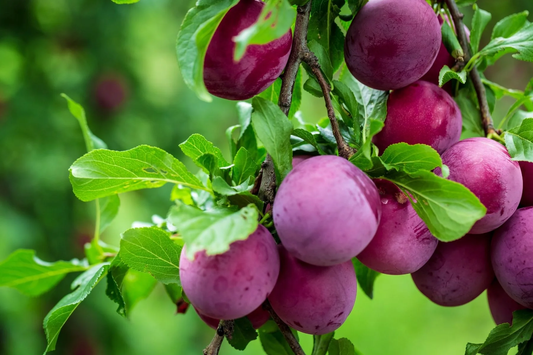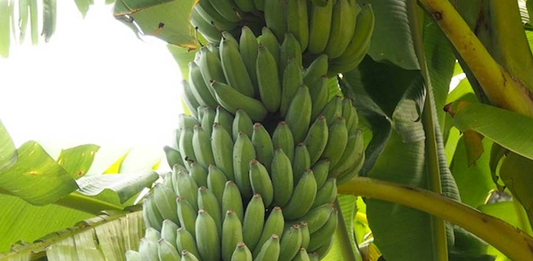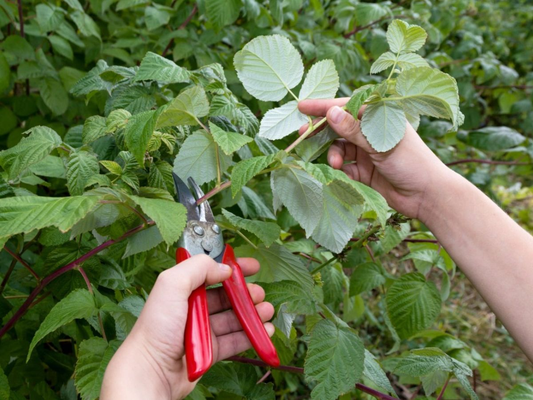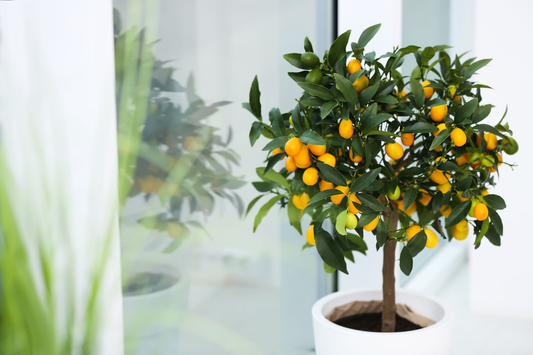The Best Fruits for Small Gardens You Won't Believe Can Fit in Your Backyard!
Share
Table of Contents
1. Introduction
Small gardens may present unique challenges, but they also offer incredible potential for those willing to maximize their space. With thoughtful planning and smart choices, even the smallest of gardens can become thriving spaces for fruit-bearing plants. Whether you have a tiny balcony, a small backyard, or a rooftop, you can transform any space into a productive garden. In this guide, we'll explore the benefits and strategies for growing fruits in small gardens, and how you can optimize your limited space.
Here are a few common challenges that small gardens present:
- Limited space for planting multiple fruit trees.
- Potential lack of sunlight for certain fruits.
- Difficulty in managing soil quality and irrigation for small areas.
Despite these challenges, maximizing space for fruit-bearing plants can turn a small garden into a source of fresh, homegrown produce. Here's why it’s worth the effort:
- Fresh Produce: Growing your own fruits ensures that you have access to fresh, seasonal produce throughout the year.
- Aesthetic Value: Fruit trees can add beauty to any garden with their vibrant colors, fragrant flowers, and attractive foliage.
- Environmental Benefits: Fruit trees help improve air quality, provide shade, and contribute to biodiversity.
- Cost Savings: Growing your own fruits can reduce your grocery bills, especially for fruits that are typically expensive to purchase.
In the following sections, we’ll delve deeper into how to choose the best fruits for small gardens, how to make the most out of your limited space, and the many benefits that fruit-bearing plants can bring to your small garden.

2. Why Choose Fruits for Small Gardens?
Growing fruits in small gardens can be a rewarding experience that offers numerous advantages. Despite limited space, fruit trees can be highly productive, allowing you to enjoy fresh, homegrown produce. Here’s why you should consider choosing fruits for small spaces:
- Maximized Space: Fruits can be grown in small spaces using creative techniques, such as vertical gardening and container planting. By making the most of available space, you can grow multiple varieties of fruit without feeling cramped.
- Low Maintenance: Many fruit trees and plants are surprisingly low maintenance, requiring only basic care to produce a bountiful harvest. Dwarf varieties, in particular, are easy to manage and don’t take up too much space.
- High Yield: When properly cared for, fruit trees in small gardens can produce a high yield of delicious fruits, often more than enough to meet your needs for fresh produce.
Fruit trees can actually be more space-efficient than some people realize. With the right varieties and techniques, you can have a thriving fruit garden even in the smallest of spaces:
- Dwarf Varieties: These compact trees are perfect for small gardens. Dwarf fruit trees, such as 'Pixie' apple or 'Compacta' pear, grow to a fraction of the size of standard trees, making them ideal for limited space.
- Espalier Techniques: Espalier is the practice of training fruit trees to grow flat against a wall or trellis, making them an excellent option for narrow spaces like fences and patios.
- Container Planting: Many fruit trees, including citrus and figs, can thrive in pots or containers, making them perfect for balcony or patio gardens.
By incorporating these space-saving methods, you can enjoy a fruitful garden, no matter how small your available space is.
3. Key Considerations When Selecting Fruits for Small Gardens
Choosing the right fruits for your small garden is essential to ensure that your plants thrive and produce high-quality fruit. There are several factors to consider when selecting fruit trees and plants for compact spaces, including space requirements, climate, growth habits, and growing conditions.
Space Requirements
When you’re working with limited space, it’s important to choose fruit trees and plants that fit your available area. Consider these space-saving options:
- Vertical Gardening: Growing fruit trees vertically using trellises, fences, or walls can save space and add a decorative touch to your garden.
- Container Gardening: Many fruits, such as citrus, figs, and strawberries, thrive in containers. This is a great option for small patios, balconies, or even windowsills.
- Compact Varieties: Look for compact or dwarf varieties that are specifically bred to grow in small spaces while still producing abundant fruit.
Climate
It’s crucial to select fruits that are suited to your region’s climate. Different fruits have varying temperature and moisture needs, so understanding your local climate is key to success. Consider the following:
- Hardiness Zones: Check your USDA hardiness zone to see which fruits will thrive in your area. Apples, pears, and cherries, for example, do well in cooler climates, while citrus and figs are better suited to warmer regions.
- Frost Tolerance: Choose fruits that are frost-tolerant if you live in a region with early or late frosts, or opt for varieties that bloom later in the season.
Growth Habits
Choosing compact, low-maintenance fruit trees is a great strategy for small gardens. These types of fruit trees require less space and are easier to care for:
- Dwarf Varieties: Dwarf fruit trees like 'Ballerina' apples or 'Baby' oranges are ideal for small gardens and offer a higher yield in less space.
- Self-Pollinating Trees: Opt for self-pollinating fruit trees, such as 'Montmorency' cherries or 'Patio' peaches, to eliminate the need for multiple trees or complicated pollination requirements.
Growing Conditions
Understanding the growing conditions required by different fruit trees will help ensure that your plants thrive. Pay attention to the following:
- Light Requirements: Most fruit trees need at least 6-8 hours of direct sunlight each day to produce fruit. Be sure to select fruits that are suited to your garden's sun exposure.
- Soil Needs: Ensure that your garden has well-draining soil with adequate nutrients. Some fruits, like blueberries, require acidic soil, while others, such as apples, prefer slightly alkaline soil.
- Watering: Fruits require consistent watering, especially in containers. Consider irrigation systems like drip lines or self-watering containers to keep your plants hydrated.

4. Top 10 Best Fruits for Small Gardens
When it comes to growing fruits in small gardens, selecting the right varieties is crucial. Below are the top 10 fruits that thrive in compact spaces, providing you with a variety of options for a fruitful and space-efficient garden.
Apple Trees
Apple trees are a fantastic choice for small gardens, particularly when you opt for dwarf varieties. These trees grow to a fraction of the size of standard apple trees but still produce delicious, full-sized fruit.
- Dwarf Apple Varieties: 'Miniature Fuji' and 'Ballerina Apples' are perfect for small gardens, as they have a compact growth habit and can fit into containers or smaller spaces.
- Space Requirements: Dwarf apple trees can be grown in pots or small garden beds, typically reaching 3-4 feet in height.
- Growing Tips: Regular pruning will help maintain a manageable size and ensure healthy fruit production. Place in full sun and well-draining soil.
| Variety | Height | Space Requirements | Fruit Size |
|---|---|---|---|
| 'Miniature Fuji' | 3-4 feet | Container or small bed | Medium |
| 'Ballerina Apples' | 3-4 feet | Container or small bed | Medium |
Pros and Cons
- Pros: Compact size, perfect for containers, easy to maintain.
- Cons: Requires regular pruning, may need cross-pollination depending on variety.
Strawberries
Strawberries are an excellent choice for small gardens, and they can be grown in containers, hanging baskets, or raised beds, maximizing your space.
- Varieties: 'Everbearing' and 'Alpine Strawberries' are great options for small spaces, producing multiple harvests per season.
- Growing Tips: Plant in well-draining soil, ensuring they get at least 6 hours of sunlight per day. Use containers or hanging baskets to conserve ground space.
Pros and Cons
- Pros: Low maintenance, produces fruit quickly, perfect for containers or vertical gardening.
- Cons: Susceptible to pests, requires regular watering and good drainage.
Lemon Trees
Dwarf lemon trees like the 'Improved Meyer Lemon' are ideal for small spaces, especially if you live in a sunny climate. They thrive in containers and can be moved indoors during colder months.
- Best for Sunny Spots: Place your lemon tree in full sunlight, ideally near a south-facing window or outdoor space with lots of sunlight.
- Container Planting: Growing in containers allows for easy mobility, ideal for small garden spaces or patios.
Pros and Cons
- Pros: Produces aromatic fruit, thrives in containers, great for warm climates.
- Cons: Requires lots of sunlight, needs regular watering, susceptible to pests like aphids.
Figs
Fig trees are perfect for small gardens and container planting. Varieties like 'Petite Negra' and 'Brown Turkey Fig' are compact yet produce abundant fruit.
- Best Varieties for Small Gardens: 'Petite Negra' and 'Brown Turkey Fig' are excellent options for small spaces.
- Space-Saving Tips: Container-growing fig trees can be easily moved around, and pruning will help maintain a manageable size.
Pros and Cons
- Pros: Produces sweet, nutritious fruit, thrives in containers, easy to maintain.
- Cons: Can require a warm climate, susceptible to root rot if overwatered.
Blueberries
Blueberries can thrive in small garden beds or containers, making them perfect for compact spaces. Varieties like 'Patriot' and 'Top Hat' are well-suited for smaller gardens.
- Growing in Pots: Blueberries are ideal for container gardening, providing flexibility to grow them on patios or balconies.
- Recommended Varieties: 'Patriot' and 'Top Hat' are compact varieties that yield high-quality fruit.
Pros and Cons
- Pros: High in antioxidants, easy to grow in containers, attractive foliage.
- Cons: Requires acidic soil, susceptible to pests like birds and aphids.
Peach Trees
Dwarf and semi-dwarf peach trees are ideal for small gardens. With proper pruning, these trees can produce a plentiful harvest without taking up too much space.
- Dwarf Varieties: 'Bonanza' and 'Golden Glory' are excellent for small spaces and offer delicious peaches.
- Pruning Tips: Regular pruning helps maintain tree size and promotes healthy fruit production.
Pros and Cons
- Pros: Produces sweet, juicy fruit, can grow in containers, good for warmer climates.
- Cons: Requires maintenance, susceptible to diseases like peach leaf curl.
Raspberries
Raspberries can be grown in containers or on trellises in small gardens. Varieties like 'Heritage' and 'Fall Gold' are well-suited for compact spaces.
- Growing in Containers: Raspberries thrive in pots or raised beds, making them a great option for small gardens.
Pros and Cons
- Pros: Quick-growing, easy to maintain, great for vertical gardening.
- Cons: Can spread quickly, may need pruning to control growth.
Grapes
Grapes can be grown on small trellises or fences, making them a perfect fit for limited spaces. Varieties like 'Compact Concord' and 'Patio Seedless' are great for small gardens.
- Growing on Trellises: Train grapes to grow on trellises or fences to save space and encourage vertical growth.
Pros and Cons
- Pros: High yield, perfect for small trellises or fences, delicious fruit.
- Cons: Requires pruning, susceptible to pests like Japanese beetles.
Pineapple Guava (Feijoa)
Pineapple Guava is perfect for small garden beds or containers. Varieties like 'Mammoth' and 'Variegata' are excellent for compact spaces.
- Growing in Containers: Ideal for container gardening, pineapple guava can be moved around for the best sun exposure.
Pros and Cons
- Pros: Unique flavor, grows well in containers, attractive foliage.
- Cons: Needs a warm climate, can be sensitive to frost.
Fig Trees
Fig trees like 'Petite Negra' and 'Brown Turkey Fig' are excellent choices for small gardens and containers. They require minimal space but produce a lot of fruit.
- Growing Tips: Prune regularly and ensure they get enough sunlight.
Pros and Cons
- Pros: Sweet fruit, low maintenance, ideal for containers.
- Cons: Needs a warm climate, susceptible to overwatering.

5. Space-Saving Techniques for Growing Fruits in Small Gardens
Maximizing space in a small garden while growing fruit trees and plants is possible with a few creative techniques. Below are some of the most effective space-saving methods for fruit gardening.
Vertical Gardening
Vertical gardening is an excellent way to grow fruit trees and plants in small spaces. By utilizing vertical structures such as trellises, fences, or wall-mounted systems, you can grow fruits upwards rather than outwards, saving valuable ground space.
- Trellises: These are perfect for growing climbing fruits like grapes, raspberries, or even certain varieties of beans. Place them against a fence or wall to create a vertical garden.
- Fences: Use fences to train fruit vines or espalier trees. This technique allows fruits to grow in a two-dimensional plane while being supported by the fence.
- Wall-Mounted Structures: Vertical wall planters or frames can hold smaller fruits like strawberries or herbs, which can be grown vertically on a wall, giving your garden a clean, organized appearance.
Espalier Trees
Espalier is the technique of training fruit trees to grow flat against a wall or fence. This method is ideal for small spaces as it limits the tree's horizontal spread while maximizing fruit production. Espalier trees are typically pruned to grow in specific patterns along a trellis or wire system.
- Best Fruit Trees for Espalier: Apples, pears, and citrus trees are among the best options for espalier due to their natural branching structure. These trees respond well to pruning and can be shaped into various forms, from simple horizontal rows to intricate fan patterns.
- Implementing Espalier: Start by installing a support system, such as a fence or trellis, and gently train the tree’s branches to grow along the structure. Prune the tree regularly to maintain the desired shape and size.
Container Gardening
Container gardening is an ideal solution for small spaces or patios. Growing fruit trees in pots allows you to move them to optimize sunlight or temperature, and it’s perfect for renters or people with limited ground space.
- Choosing the Right Container: Choose a pot that is large enough for the tree’s root system to grow but not too large, as it can lead to water retention issues. Ensure there are drainage holes at the bottom.
- Soil Selection: Use well-draining, nutrient-rich soil specifically designed for fruit trees. Regularly check the moisture level, as container trees dry out faster than those in the ground.

6. Best Companion Plants for Fruits in Small Gardens
Companion planting is a gardening technique that pairs plants together to promote growth, enhance flavor, improve yields, and naturally repel pests. In small gardens, it’s especially useful for maximizing space and improving the health of fruit trees and plants.
Explanation of Companion Planting
Companion planting involves growing different plants near each other to benefit from their interactions. Some plants improve soil conditions, while others help repel pests or attract beneficial insects. By choosing the right companion plants, you can enhance the growth of your fruit trees and plants, reduce the need for chemical pesticides, and boost the overall productivity of your garden.
Examples of Companion Plants for Fruits
Here are some examples of effective companion plants for common fruit trees and plants:
- Basil with Tomatoes: Basil helps improve the flavor of tomatoes and deters pests like mosquitoes and flies.
- Thyme with Strawberries: Thyme helps attract beneficial insects and repels pests that can harm strawberries.
- Marigolds with Fruit Trees: Marigolds act as a natural pest repellent, especially against aphids and nematodes that can damage fruit trees.
- Garlic with Apple Trees: Garlic deters pests like aphids and caterpillars, benefiting apple trees.
Benefits of Growing Herbs and Flowers Alongside Fruit Plants
Growing herbs and flowers alongside your fruit plants can provide multiple benefits, such as attracting pollinators, deterring harmful pests, and enriching the soil with nutrients. Additionally, herbs like mint and rosemary can help control weed growth and improve the flavor and yield of your fruit crops.
7. Maintaining Small Garden Fruit Trees: Care and Maintenance Tips
Maintaining small garden fruit trees requires attention to detail and a few key practices to ensure healthy growth and productive yields. Below are essential care and maintenance tips for fruit trees in small spaces.
Pruning and Shaping for Small Fruit Trees
Pruning and shaping your small fruit trees is crucial for keeping them healthy and compact, especially when space is limited. Regular pruning helps maintain the tree’s shape, improves air circulation, and encourages fruit production. Here are some tips:
- Prune for Shape: For small trees, prune to maintain a manageable shape, such as a central leader or bushy form, to maximize sunlight exposure.
- Remove Dead or Diseased Branches: Regularly remove dead, damaged, or diseased branches to prevent the spread of pests and diseases.
- Focus on Fruit-bearing Branches: Trim branches that don’t produce fruit to encourage new growth on fruitful areas.
Fertilization Tips for Maximizing Fruit Production
Proper fertilization is key to maximizing fruit production in small garden fruit trees. A healthy balance of nutrients ensures trees grow strong and yield abundant fruit. Here are a few fertilization tips:
- Use Organic Fertilizers: Organic options like compost or well-rotted manure are ideal for providing long-term nutrients.
- Feed in Spring: Fertilize in early spring before the growing season starts, as this gives trees a nutrient boost for optimal growth.
- Avoid Over-fertilization: Excessive fertilizer can lead to too much foliage growth at the expense of fruit production, so apply sparingly.
Dealing with Pests and Diseases in Small Garden Settings
In small gardens, pest and disease management is essential to protect your fruit trees. Many pests can be controlled naturally with a few simple strategies:
- Introduce Beneficial Insects: Beneficial insects like ladybugs and predatory mites can help keep harmful pests like aphids in check.
- Use Organic Pesticides: If needed, use organic solutions such as neem oil or insecticidal soap to control pests.
- Practice Crop Rotation: Rotate the location of fruit plants each year to reduce the buildup of pests and diseases in the soil.
Watering and Soil Management for Small Fruit Gardens
Proper watering and soil management are essential for fruit tree health, particularly in small garden settings where space and resources are limited. Here are tips for successful watering and soil management:
- Water Deeply, Not Frequently: Water the trees deeply to encourage strong root growth, but avoid over-watering, which can lead to root rot.
- Check Soil Drainage: Ensure your soil drains well to prevent waterlogging. If necessary, amend the soil with organic material to improve drainage.
- Mulch Around Trees: Apply mulch around the base of trees to retain moisture, suppress weeds, and maintain soil temperature.
8. Harvesting and Storing Your Fruits
Harvesting fruits at the right time and storing them properly are essential steps to ensure you enjoy the best flavor and maximize your crop's shelf life. For small gardens, it’s important to know how to handle fruits once they're ripe and how to preserve them for later use.
How to Harvest Fruit at the Right Time for Optimal Flavor
Harvesting at the right time ensures optimal flavor and quality. Look for these signs to determine when to pick your fruit:
- Color: The fruit should have reached its mature color, which varies by type.
- Firmness: Gently squeeze or feel for a firm texture—ripe fruits should yield slightly.
- Aroma: A sweet, fragrant aroma usually indicates ripeness, especially in fruits like peaches and melons.
Storing Fruits for Longer Shelf Life
Proper storage can extend the shelf life of fruits from small gardens. Some tips include:
- Refrigerate Perishables: Fruits like berries, apples, and grapes should be kept in the fridge.
- Cool, Dry Place: For fruits like bananas and peaches, store them in a cool, dry area to prevent spoilage.
- Use Ventilated Containers: Store fruits in breathable containers to avoid moisture buildup, which can cause rot.
Preserving Techniques (Canning, Freezing, Drying) for Fruits from Small Gardens
To preserve fruits for longer periods, consider these methods:
- Canning: Process fruits in jars to store them at room temperature for extended shelf life.
- Freezing: Freeze fruits like berries and peaches for long-term storage.
- Drying: Dry fruits such as apples and figs for a shelf-stable snack.

9. Common Mistakes to Avoid When Growing Fruits in Small Gardens
Growing fruits in small gardens can be incredibly rewarding, but it’s easy to make mistakes that hinder growth or fruit production. Here are some common errors to avoid:
Overcrowding Plants
One of the most common mistakes is planting too many trees or plants too close together. Overcrowding leads to competition for nutrients, light, and space, which can stunt growth and reduce fruit production. Always ensure you give each plant enough space to thrive.
Planting Trees That Are Too Large for the Space
Choosing fruit tree varieties that grow too large for your small garden can cause significant issues. Larger trees can quickly take over limited space, resulting in reduced airflow and light exposure. Always select dwarf or semi-dwarf varieties that are better suited for confined areas.
Ignoring Proper Pruning or Care
Neglecting to prune and care for your fruit trees can lead to overcrowded, unhealthy growth. Regular pruning helps maintain the tree’s shape, encourages healthy fruit production, and reduces the risk of pests and diseases. Make sure to stay on top of seasonal care to keep your trees thriving.
Choosing the Wrong Varieties for Your Climate and Space
Choosing fruit tree varieties that are not suited to your climate or space can result in poor growth or fruit production. It’s essential to research the best varieties for your region’s temperature and space limitations, ensuring the trees you select are suited to thrive in your garden conditions.
10. Conclusion
In conclusion, there are many wonderful fruit options that can thrive in small gardens, from compact apple trees to sweet strawberries and blueberries. With the right space-saving techniques, such as vertical gardening, espalier, and container planting, even the smallest garden can produce a bountiful harvest. Dwarf varieties and smart care practices make it possible for anyone to enjoy fresh, homegrown fruits no matter the size of their outdoor space.
Don’t be discouraged if you think your garden is too small for fruit trees—start small, and over time, you’ll reap the rewards of homegrown produce. The key is choosing the right varieties, properly caring for your plants, and making the most of your available space. Whether you’re a beginner or an experienced gardener, growing fruits in a small garden is not only possible but incredibly satisfying.
To maximize your small garden’s potential, remember to plan ahead, prune regularly, and take care of your plants' needs. With patience and the right techniques, you’ll soon have a thriving fruit garden to enjoy year-round.
11. Frequently Asked Questions (FAQ)
Here are some commonly asked questions about growing fruits in small gardens:
1. What are the best fruits for a shaded small garden?
If your garden doesn’t get much sunlight, there are still several fruit options that thrive in partial or full shade, such as:
- Strawberries – Can grow well in partial shade.
- Raspberries – Tolerate shaded areas and produce fruit in cooler climates.
- Currants – These hardy shrubs grow well in shade.
2. Can I grow fruit trees indoors in small spaces?
Yes, dwarf fruit trees are perfect for indoor growing. Varieties like the Meyer Lemon and Miniature Apple Trees can thrive in pots on windowsills with adequate light. Indoor fruit trees often need extra care with temperature and humidity management, but they are a great option for small indoor spaces.
3. How often should I water my fruit trees in small gardens?
Fruit trees in small gardens typically need watering once or twice a week, depending on weather conditions. Ensure the soil is well-drained to avoid overwatering, which can lead to root rot. Water deeply to encourage strong root systems, especially during dry periods or when the trees are young.
4. Can I grow more than one fruit tree in a small space?
Yes, you can grow multiple fruit trees in small spaces! Opt for dwarf or semi-dwarf varieties, and use space-saving techniques like espalier, vertical gardening, or container gardening to maximize space. Planting trees with compatible growth habits will ensure they don’t crowd each other out.
5. How long does it take for fruit trees in small gardens to produce fruit?
The time it takes for fruit trees to produce fruit varies by species and growing conditions. Dwarf fruit trees typically produce fruit within 2 to 4 years, while standard-sized trees may take longer. Patience is key, but with proper care, you’ll enjoy a fruitful harvest in no time.
6. Are dwarf fruit trees really smaller than regular trees?
Yes, dwarf fruit trees are specifically bred to grow to smaller sizes, making them ideal for small spaces. They reach a height of 3 to 8 feet, compared to regular trees that can grow much taller. Dwarf trees still produce full-sized fruit but require less space and care.
Additional Resources
How to Grow Carrots in Containers – Your Guide to Fresh, Homegrown Pro – XRoci
How to Care for Jade Plants: The Beginner's Guide to Keeping Your Plan – XRoci
How to Start an Indoor Vegetable Garden: The Surprising Benefits You D – XRoci




